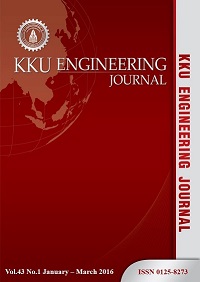Filtration efficiency and filter resistance of nylon-6 and nylon-6/chitosan nanofibrous membranes
Main Article Content
Abstract
Pore size reduction of nanofibrous membranes and the removal efficiencies for submicron PS particles (410, 200, 90 and 50 nm) were investigated in this study. Blending chitosan with nylon-6 generated ultrafine fibers among typical nanofibers produced an electrospun membrane with a smaller average pore size. It was found that high molecular weight chitosan could increase the filtration efficiency to a greater degree than low molecular weight chitosan. The best membrane was obtained from a solution of 30% wt/v nylon-6 and 0.06% wt/v chitosan. It had an average fiber size of around 128 nm, average pore size of 110 nm and a thickness of 0.1 mm. While it could completely remove larger particles, it gave a removal efficiency of 94% for 50-nm particles when it was used as a single-layer membrane and up to 97% as a double-layer of membranes with an overall thickness of 0.17 mm. It had a greater removal efficiency than a commercial nylon membrane and smaller pore sizes. Therefore, it has a potential to be used for sterilization of contaminated water.
Article Details
This work is licensed under a Creative Commons Attribution-NonCommercial-NoDerivatives 4.0 International License.



